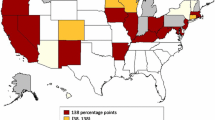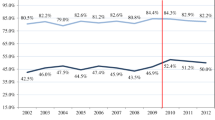Abstract
This paper identifies the effect of the Affordable Care Act’s dependent coverage mandate on health insurance coverage and labor market outcomes among young adults by exploiting the discrete change in health insurance coverage at age 26. Using a regression discontinuity design, we find that aging out from the ACA’s dependent coverage mandate is associated with up to a 4.2-percentage-point decrease in private insurance coverage at age 26. We also find that aging out from the mandate is significantly associated with an increase in the probability of being employed. However, we do not find any significant changes in hourly wage, weekly working hours or job mobility at age 26.

Source: MEPS Panel 15–18 (2010–2014)

Source: MEPS Panel 15–18 (2010–2014)

Source: MEPS Panel 15–18 (2010–2014)

Source: MEPS Panel 15–18 (2010–2014)
Similar content being viewed by others
Notes
In our RD parametric estimation, we mainly rely on estimation results from sample with age bandwidths of 24 months. But we report our results of 12, 36, 48 months in “Appendix.”
Since the exact date of birth is not available in MEPS-HC, we cannot calculate exact days of each respondent before and after 26th birthday.
All job-specific variables refer to a person’s current main job. The current main job, defined by the respondent, indicates the main source of employment.
All job-specific variables refer to a person’s current main job. The current main job, defined by the respondent, indicates the main source of employment. A current main job was defined for persons who either reported that they were currently employed and identified a current main job or who reported and identified a job to return to. Therefore, job-specific information such as hourly wage exists for persons not presently working at the interview date but who have a job to return to as of the interview date.
Due to confidentiality concerns, hourly wages greater than or equal to $78.00 were top-coded to $78.00.
Not rely on, however, we still present the estimators from models with cubic polynomials in “Appendix”.
Although not reported here, we also include cubic polynomials of forcing variable fully interacted with the dummy variable for parametric models, and nonparametric models under rectangular and triangular kernels as robustness checks. See Table 7 in Appendix for detailed results.
References
Anderson, Michael, Carlos Dobkin, and Tal Gross. 2012. The Effect of Health Insurance Coverage on the Use of Medical Services. American Economic Journal: Economic Policy 4(1): 1–27.
Antwi, Yaa A., Asako S. Moriya, and Kosali I. Simon. 2013. Effects of Federal Policy to Insure Young Adults: Evidence from the 2010 Affordable Care Act Dependent Coverage Mandate. American Economic Journal: Economic Policy 5(4): 1–28.
Bailey, James. 2017. Health Insurance and the Supply of Entrepreneurs: New Evidence from the Affordable Care Act. Small Business Economics 3: 627.
Bailey, James, and Anna Chorniy. 2016. Employer-Provided Health Insurance and Job Mobility: Did the Affordable Care Act Reduce Job Lock? Contemporary Economic Policy 34(1): 173–183.
Barbaresco, Silvia, Charles J. Courtemanche, and Yanling Qi. 2015. Impacts of the Affordable Care Act Dependent Coverage Provision on Health-Related Outcomes of Young Adults. Journal of Health Economics 40: 54–68.
Cantor, Joel C., Alan C. Monheit, Derek DeLia, and Kristen Lloyd. 2012. Early Impact of the Affordable Care Act on Health Insurance Coverage of Young Adults. Health Services Research 47(5): 1773–1790.
Colman, Gregory, and Dhaval Dave. 2018. It’s about Time: Effects of the Affordable Care Act Dependent Coverage Mandate on Time Use. Contemporary Economic Policy 36(1): 44.
Dahlen, Heather M. 2015. “Aging Out” of Dependent Coverage and the Effects on Us Labor Market and Health Insurance Choices. American Journal of Public Health 105: S640–S650.
Depew, Briggs. 2015. The Effect of State Dependent Mandate Laws on the Labor Supply Decisions of Young Adults. Journal of Health Economics 39: 123–134.
Dillender, Marcus. 2014. Do More Health Insurance Options Lead to Higher Wages? Evidence from States Extending Dependent Coverage. Journal of Health Economics 36: 84–97.
Ertan Yörük, Ceren. 2015. The Effect of Alcohol Consumption on Labor Market Outcomes of Young Adults: Evidence from Minimum Legal Drinking Age Laws. B.E. Journal of Economic Analysis & Policy 15(3): 1297.
Fairlie, Robert W., Kanika Kapur, and Susan Gates. 2011. Is Employer-Based Health Insurance a Barrier to Entrepreneurship? Journal of Health Economics 30: 146–162.
Gelman, Andrew, and Guido Imbens. 2014. Why High-Order Polynomials Should Not Be Used in Regression Discontinuity Designs. NBER working paper no. 20405. http://www.nber.org/papers/w20405.
Gruber, Jonathan, and Brigitte C Madrian. 2002. Health Insurance, Labor Supply, and Job Mobility: A Critical Review of the Literature. NBER working papers, February, 1. http://www.nber.org/papers/w8817.
Hahn, Jinyong, Petra Todd, and Wilbert van der Klaauw. 2001. Identification and Estimation of Treatment Effects with a Regression-Discontinuity Design. Econometrica 1: 201–209.
Himmelstein, David U., Elizabeth Warren, Deborah Thorne, and Steffie Woolhandler. 2005. Illness and Injury as Contributors to Bankruptcy. Health Affairs 24(Suppl 1): W5-63–W5-73.
Holahan, J., and G. Kenney. 2008. Health Insurance Coverage of Young Adults. American Community Survey Briefs (September), 6.
Kirzinger, Whitney K., Robin A. Cohen, and Renee M. Gindi. 2013. Trends in Insurance Coverage and Source of Private Coverage Among Young Adults Aged 19–25: United States, 2008–2012. NCHS data brief, no 137. Hyattsville, MD: National Center for Health Statistics.
Lee, David S., and Thomas Lemieux. 2010. Regression Discontinuity Designs in Economics. Journal of Economic Literature 48(2): 281–355.
Levine, Phillip B., Robin McKnight, and Samantha Heep. 2011. How Effective are Public Policies to Increase Health Insurance Coverage of Young Adults? American Economic Journal: Economic Policy 3(1): 129–156.
Monheit, Alan C., Joel C. Cantor, Derek DeLia, and Dina Belloff. 2011. How have State Policies to Expand Dependent Coverage Affected the Health Insurance Status of Young Adults. Health Services Research 46(1): 251–267.
Slusky, D.J.G. 2013. Revisiting the Labor Effects of the Affordable Care Act. Princeton University Working Paper.
Sommers, Benjamin D., and Richard Kronick. 2012. The Affordable Care Act and Insurance Coverage for Young Adults. Journal of the American Medical Association 307(9): 913–914.
Sommers, Benjamin D., Thomas Buchmueller, Sandra L. Decker, Colleen Carey, and Richard Kronick. 2013. The Affordable Care Act Has Led to Significant Gains in Health Insurance and Access to Care for Young Adults. Health Affairs 32: 165–174.
Wellington, Alison J. 2001. Health Insurance Coverage And Entrepreneurship. Contemporary Economic Policy 19: 465–478.
Yörük, Baris K., and Ceren Ertan Yörük. 2011. The Impact of Minimum Legal Drinking Age Laws on Alcohol Consumption, Smoking, and Marijuana Use: Evidence from a Regression Discontinuity Design Using Exact Date of Birth. Journal of Health Economics 4: 740.
Acknowledgements
We thank the participants in the special session at Eastern Economic Association 44th Annual Conference at Boston, MA, and three anonymous referees for their valuable and helpful comments.
Author information
Authors and Affiliations
Corresponding author
Rights and permissions
About this article
Cite this article
Yörük, B.K., Xu, L. Impact of the ACA’s Dependent Coverage Mandate on Health Insurance and Labor Market Outcomes Among Young Adults: Evidence from Regression Discontinuity Design. Eastern Econ J 45, 58–86 (2019). https://doi.org/10.1057/s41302-018-0123-8
Published:
Issue Date:
DOI: https://doi.org/10.1057/s41302-018-0123-8
Keywords
- Health insurance
- ACA’s dependent coverage mandate
- Employment
- Job mobility
- Regression discontinuity design




